Yesterday, I posted an essay about domestic and wild creatures who live in and around our house, and I explained why I’m writing about animals this week. You can read that post here for context if you like. Sharing personal stories that depart from my core topic of mountain/ultra/trail running is a bit of an experiment, and I welcome your feedback in the comment section. Next week I’ll get back to trail-running advice and adventure.
I’m missing our two horses, Cobalt and Maverick, while they temporarily reside in Santa Fe for some winter boarding and training. I miss starting the day by stepping into the predawn cold and darkness to feed them hay and inhaling deeply while at their sides, as if the scent of alfalfa and manure were freshly brewed coffee. I miss grooming their coats, picking their hooves, mucking their paddock, riding around the arena and up the road, and giving them attention and feeling it reciprocated.
People tend to know me as a runner, not a horsewoman, but riding horses was my first sport and love. We own two horses, and I’ve thought a lot about why we go to the expense and trouble. They are not working horses with a practical purpose. They are not show horses with a competitive goal. I don’t even think of riding now as a sport, the way I did when I was younger and trained for shows, because running provides athletic goals and satisfaction.
This hobby—relationship—with horses has much more to do with wellness, heritage, and an extension of homemaking and family life. Early in life, horse care and riding became equine therapy practiced intuitively. Exercising the horses in the arena, where we practice different moves and gaits, feels not unlike practicing yoga poses in terms of body awareness, balance, and mindfulness.
When Morgan and I, at our kids’ urging, bought Cobalt in 2016, we thought one horse would be enough. We would share in his care and borrow a neighbor’s horse to board in the paddock to keep Cobalt company.
This arrangement worked fine for a while. But just as Morgan and I felt certain in 2000, when our daughter Colly was 2, that we wanted another pregnancy to round out our family, so too we felt certain once we settled into a home here year-round that we wanted to find a good buddy for Cobalt and another good ride for us. Hence, as a present to ourselves in the new year of 2020, we went looking for a horse.
Horse shopping is not easy, given the high cost (around $5K to $10K for a young, good-quality quarter horse, often more than $20K for a show prospect), along with the myriad variables of health and temperament and the long distance it takes to travel to check one out.
In February of 2020, Morgan and I traveled to Salt Lake City so I could run an ultra. The SLC region is a hub of equestrian centers, so the day before the race, we visited two barns with horses for sale. The first seller specialized in buying young horses, improving their training, marketing them with Instagram posts and YouTube videos, then sending them to auction.
I had never participated in a horse auction, and what I learned about it made me nervous. I highly doubted we could bid high enough or out-maneuver a savvier buyer. We decided to visit this barn out of curiosity, but I put a businesslike seal around my heart. I vowed not to get attached to any auction-bound horse.
I first saw the horse, then named Geno, tied to the side of a trailer with three other horses for us to examine. Two things shaped my first impression: the way his black coat shined, which made the others look dull, and the way he raised his head to playfully nibble on the neck of another horse. He was like a schoolboy standing in line and poking the kid next to him for attention.
I rode each one like a test drive. I barely remember the others, except for their green behavior. One anxiously tossed his head when I lifted my hand to adjust the bridle, another scuttled sideways when I put my foot in the stirrup to mount and picked up the wrong lead at the canter.
This 5-year-old black horse, however, acted agreeably and moved like a lithe dancer, with a fluidity and responsiveness that indicated he was willing to partner. We trotted and cantered in circles, halted and backed, pivoted and sidestepped, and in doing so, we clicked. He had puppy-like spirit mixed with sweetness, and his looks turned heads.
But he was too flashy, too special. He was destined for a show ring and would likely go for double or more the opening bid. There was no way we’d get him at the auction, scheduled in Idaho on April 4, and we didn’t really want to make a trip to Idaho or figure out the backdoor method of bidding online. Buying him seemed utterly far-fetched.
But, just in case we decided to make a serious bid, we lined up a vet check to ascertain his health and soundness, and he checked out.
I said goodbye to that gorgeous creature and tried to put him out of mind as we went to another barn, where we met another quarter horse. This other horse was good looking and sweet too, trained in the specialty of reining. After a second visit the day after my race, we decided to buy him, pending a vet check. We ordered X-rays for his legs and hooves, the equivalent of hiring a mechanic to look under a used car’s hood.
Then our equine vet, who interpreted the images for us, broke the bad news: this horse was like an elite-level gymnast who’d been worked so hard as a preteen that her best athletic years were over by high school. A future with this injury-prone horse meant a lot of veterinarian treatments and limited ability to ride outside of a soft sand arena. No deal. I felt heartbroken for that horse and guilty for not making a home for him, but we wanted to ride trails and not spend a fortune on vets.
We started over on the search. And then two weeks later, the whole world changed.
On Monday, March 16, the stock market tanked due to the onset of the pandemic’s shutdown. Morgan’s business, in litigation services, was thrown into uncertainty because courts were closing indefinitely. We had spent the weekend moving our son Kyle home from CU Boulder, and Colly was flying home the next day, her senior year at RISD cut short. The ski resort had shut down, restaurants were closing, events were being canceled, and everything felt frightening and infectious.
I suppose it’s a sign that animals bring comfort that we were dwelling on horses during a day of global panic and personal financial loss. A realization hit: the April 4 horse auction probably wouldn’t happen, given the shutdown and travel bans. Maybe the owner would sell directly.
While watching the Dow make its second-biggest-ever one-day percentage drop since World War II, Morgan phoned the seller of the first horse, Geno, and suggested making a sale. We’d pay cash for what would be a reasonable starting bid.
The seller hemmed and hawed. He wanted to check with other potential buyers to see if they could make an offer. Morgan held firm: The auction wasn’t going to happen, so he could sell to us on a day when life as we know it was changing by the hour, or he’d lose a sure sale.
After a pause, he said, “Deal.”
We’d wire the funds. He’d have one of his guys meet us with the horse at a meeting point—Green River, Utah—in three days.
Morgan and I hung up and looked at each other. Oh my God, could things get any crazier? Yes.
We were elated and didn’t question spending a chunk of savings on this horse. It felt like a blink moment when everything we knew about ourselves and this horse funneled into the feeling that the snap decision was a smart one.
The auction officially got canceled in the following days, and the last text from the seller communicated some regret on his end: “Funny, I’ve had at least 8 ppl call & tell me they were going to the sale for Geno and wished I’d have reached out to them,” he wrote, ending with an emoticon of a guy shrugging.
I’m not proud to admit that three days later we broke the law and risked others’ health to drive to Utah, but that’s what we did. We violated our county’s brand-new shelter-in-place order to pick up Geno, whom we wanted to rename. With our kids, we swapped ideas until agreeing that he should be named after one of Kyle’s favorite horses earlier in life: Maverick.
At least we tried to be safe about our travel. We packed food and water for the car ride so we would not have to stop and encounter anyone. We didn’t want to catch the novel coronavirus that might be lurking who-knows-where.
But we were dodging a reality too disturbing, inconvenient, and unbelievable to confront: that we ourselves had sniffles and a dry cough.
It’s nothing, I told myself, popping a cough drop. Let’s go get this horse.
We pulled up to a gas station along the highway in Green River and, to our relief, a truck with a horse trailer sat waiting. A cowboy got out, and we walked up and waved awkwardly since we were getting used to the new reality of not shaking hands. Then he opened the trailer, and out stepped our new boy Maverick.
I took the lead rope, and Maverick looked around wide-eyed with ears pricked to cars passing on the highway. He kept turning his head to look left, then right, then left again. “It’ll be OK,” I told him, stroking his neck while he intently smelled my jacket, searching for clues and carrots.
The cowboy drove off, and Morgan and I were left to act like a host family welcoming a foreign exchange student to our home. We held our breath hoping Maverick wouldn’t balk at loading into the trailer, and with good manners and trust, he stepped in, no idea of where life would take him next.
Research informed us that he had been born in May of 2015 in Oklahoma, at a ranch that gave him the distinctive freeze brand of an octagram star on his left shoulder. (A freeze brand, less painful than a hot brand, changes the hair follicle so it no longer produces pigment and always will grow in white.) Then he was sold as a yearling stallion to a ranch in Iowa, where he was gelded and trained. Then to the Utah broker. Now, to his forever home with us.
(This post shows his homecoming and includes a video of our first ride when I was trying him out in Utah.)
Once home, Maverick settled in just fine with Cobalt. Cobalt the alpha initially pinned his ears back and tried to chase Maverick away at feeding time, but Maverick boldly stepped forward and plunged his nose next to Cobalt to get his fair share. Cobalt learned that when he’d nip Maverick, Maverick would nip back, so the sparring became less aggressive and more playful.
The problem was, Morgan and I could barely focus on the horses, or anything. One week after getting Maverick, we were coping with fevers and brain fog.
Our son Kyle, who had moved back from Boulder the prior weekend, became ill as soon as he got home with “just a cold.” In the days that followed, Morgan, Colly, and I came down with cold symptoms, fatigue, and mild fevers.
None of us wanted to believe it was covid, which was still so rare in southwest Colorado during the second half of March 2020. No testing was available to check, so we isolated and administered self-care. My kids and I got better, but Morgan didn’t.
Over an unforgettable week (told in more detail here), Morgan developed full-blown viral pneumonia and hypoxia as covid invaded both lungs. I checked him into the hospital in the middle of the night on March 28, nine days after getting Maverick, not knowing if I’d ever see him again. This was around the time when stories of people dying alone in hospitals in Italy and New York filled the news.
When my mind contemplated becoming a widow—the previously unthinkable prospect of living without the person who’s been my soulmate since high school—I of course thought about how my kids and I would cope with the loss. But I also prayed, get better for Maverick. I wanted Morgan to know and ride this new horse of ours. And I wanted Maverick and Cobalt to have two well-functioning, healthy caregivers. I wasn’t ready to be a single mom for two horses as well as for my kids.
Morgan made it out of the hospital, attached to supplemental oxygen for the following month. My deepest fear of losing him was a nightmare that still haunts me and makes me overly anxious about his health, but it did not become reality.
He took a long time to fully recover during one of the most stressful months ever professionally as he scrambled to secure loans to prevent laying off employees. On days when he could barely manage the circumstances or think clearly due to covid fatigue, caring for Maverick and Cobalt provided some hope, calm, and comfort, because other concerns fall away when you’re interacting with a horse. Horsemanship becomes a form of mindfulness-based stress reduction with a 1000-pound animal.
About 10 days after his hospital stay, when Morgan felt weak but well enough to move around outdoors, I saddled up the horses while he fixed up a backpack to carry a portable oxygen tank. Then I gave him a leg up into the saddle, and we made jokes about the Marlboro Man as he adjusted the cannula to keep oxygen flowing to his nose. He started out on Cobalt, but then we switched so he could try out his shiny new steed. Both of us breathed deeply and appreciated the views more than ever on this first ride together on this pair.
On that ride and every ride, I experience moving through the mountains from a different perspective. I’m constantly communicating with the horse through body language and looking at views framed by his ears, alert to what he might see from having eyes on the sides of his head rather than binocular vision like us. The horse is more the athlete than I, and my breathing stays calm as I guide his movement. It feels dramatically different than the heavy-breathing, self-propelled, fatiguing act of trail running. I can’t say which I like better, riding or running, just that each is deeply satisfying in its own way.
Over the past two years, I’ve watched Maverick’s rascally yet laid-back personality develop in relation to Cobalt. When I scoop manure out of the paddock, Cobalt watches indifferently, as if he has better things to do, but Maverick hovers near my shoulder. When I don’t pay him sufficient attention, he uses his mouth to shake the edge of the wheelbarrow because he is fascinated by my reaction when he tips it over.
Maverick and Cobalt pass the time nuzzling and nibbling each other (a behavior known as allogrooming), sparing rambunctiously and then sleeping peacefully. They are well matched and inseparable, breaking into high-pitched whinnies when one gets left behind.
(Click through to this post to watch a video of their play.)
They remind me so much of the sibling dynamic between my two kids, Maverick reflecting Kyle. Colly, three years older, always took the lead like Cobalt and acted more mature. She could have treated Kyle as an inferior, either ignoring or bossing him. But Kyle was too likable and funny to ignore, too clever and confident to be bossed.
I look back at photos from a decade ago, when my kids were 13 and 10—a time when their age and gender difference could have made them loathe each other—and I’m struck by their mutual love and companionship. I am so grateful for their sibling relationship, and the sum of my love for both is greater than what I feel toward each individually, which is how I feel now about the duo of Maverick and Cobalt. Clearly, horses satisfy maternal and caregiving longings that developed after my kids left home.

Maverick is our silver lining to the pandemic and a reminder to me that sometimes we should make quick, far-fetched moves and snap decisions if our gut and heart tell us it’s right. Sometimes bad timing turns out to be good, and unexpected gifts can arrive during difficult times, if you open yourself to the possibility.
And also, they remind me how blessed we are to have a partner in life, for life.

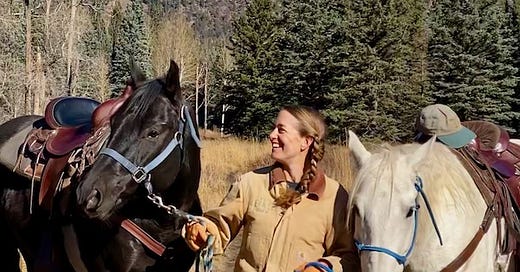



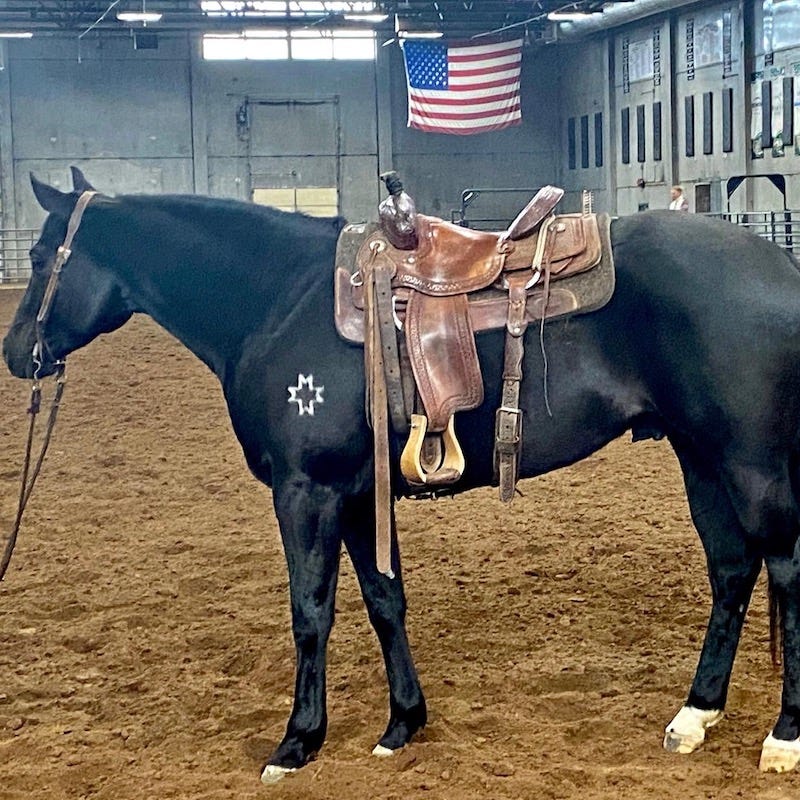


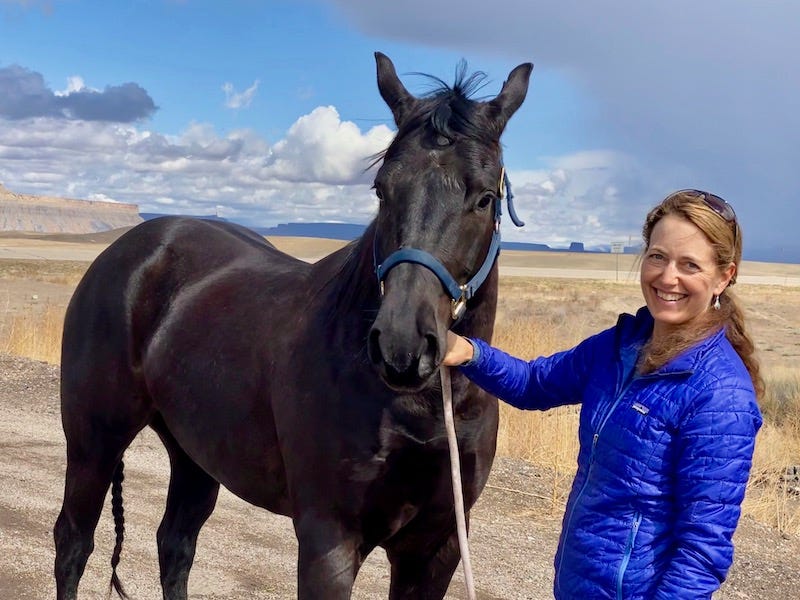


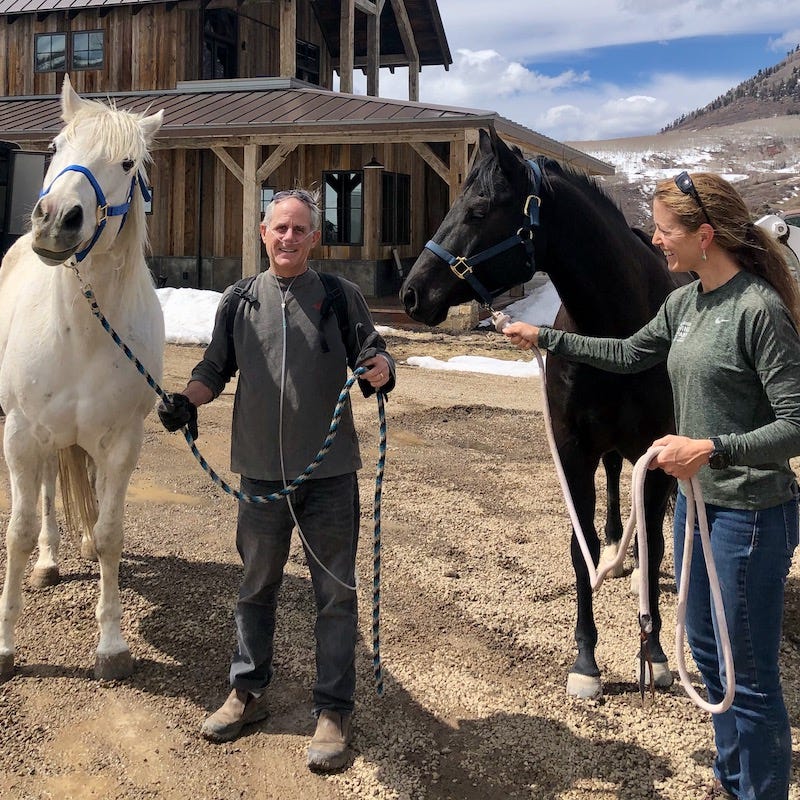

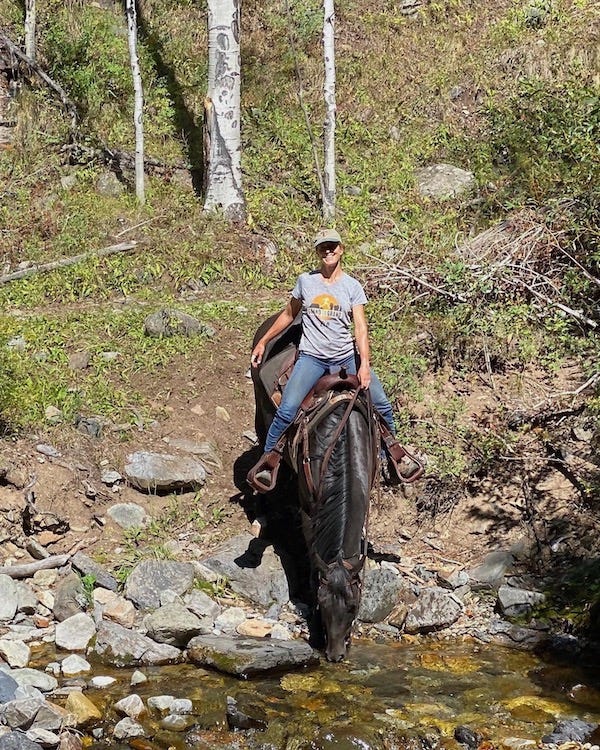
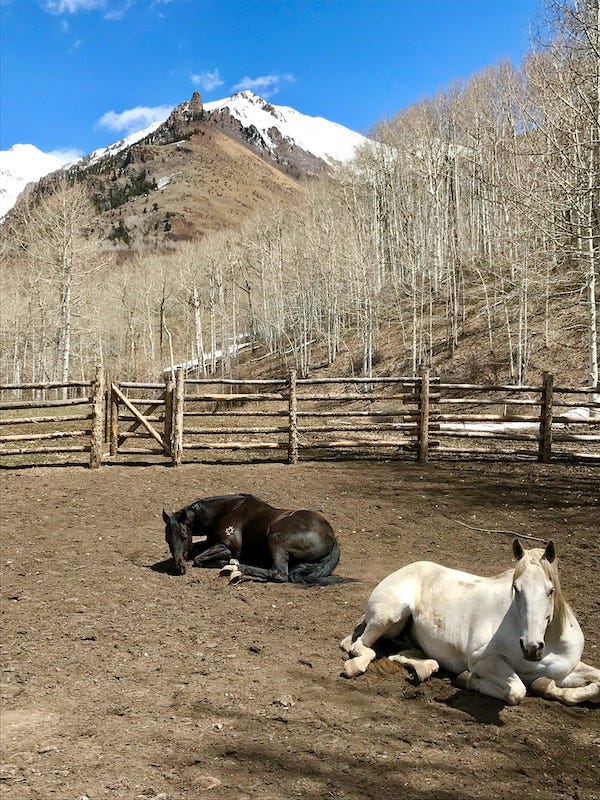

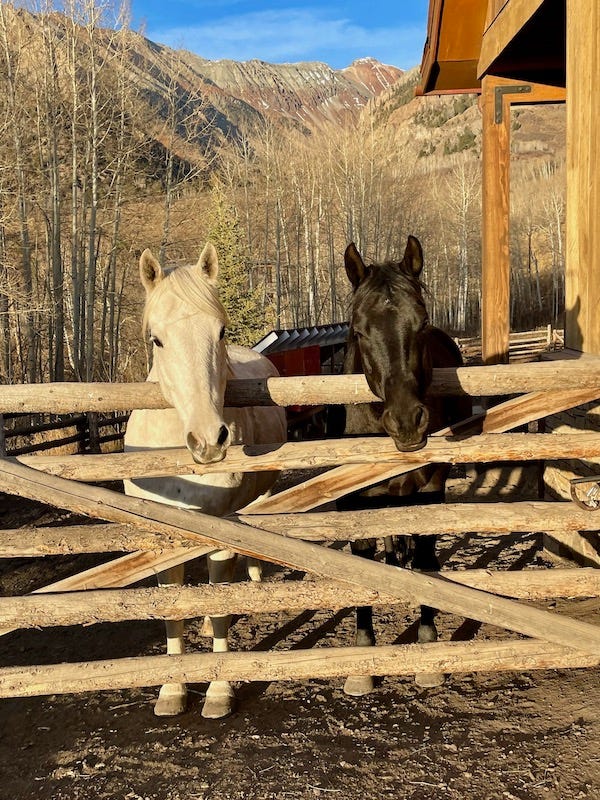
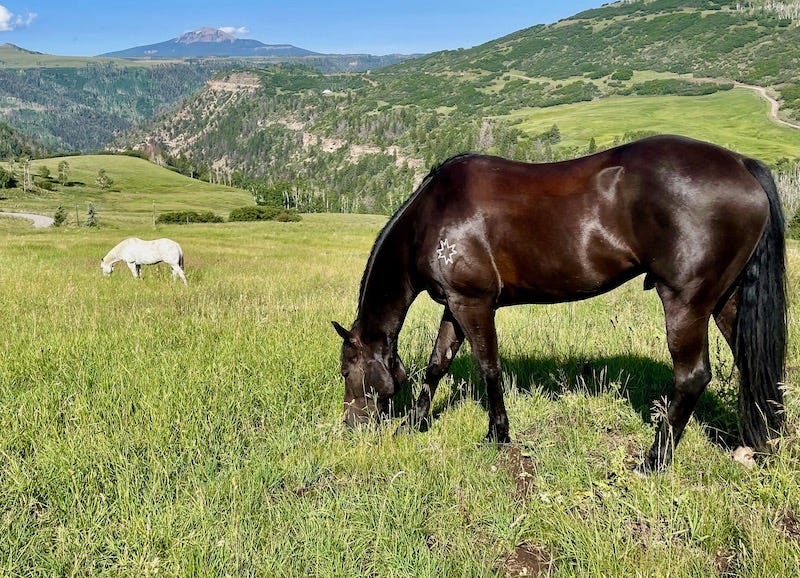
I loved getting to hear this story. So happy for you and Morgan and Maverick. <3
Your sensitive and thoughtful writing about other things besides trail running is really beautiful.